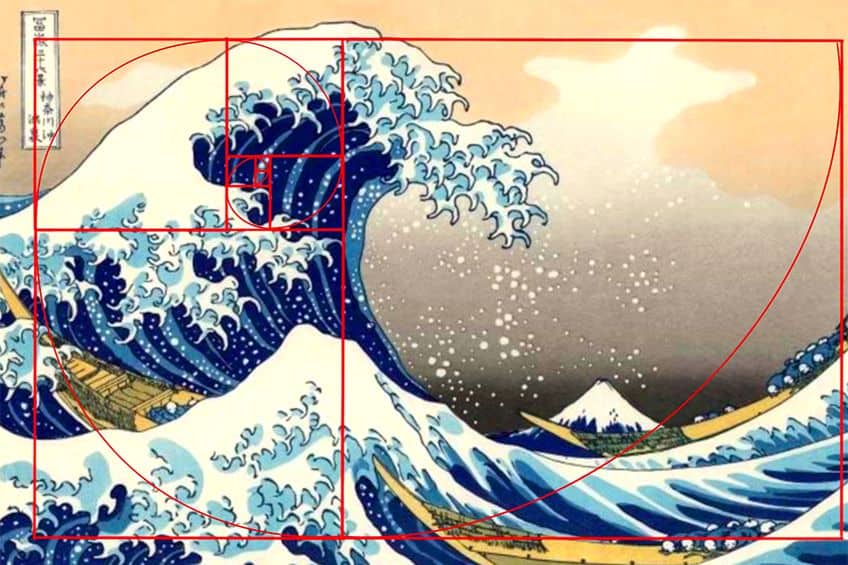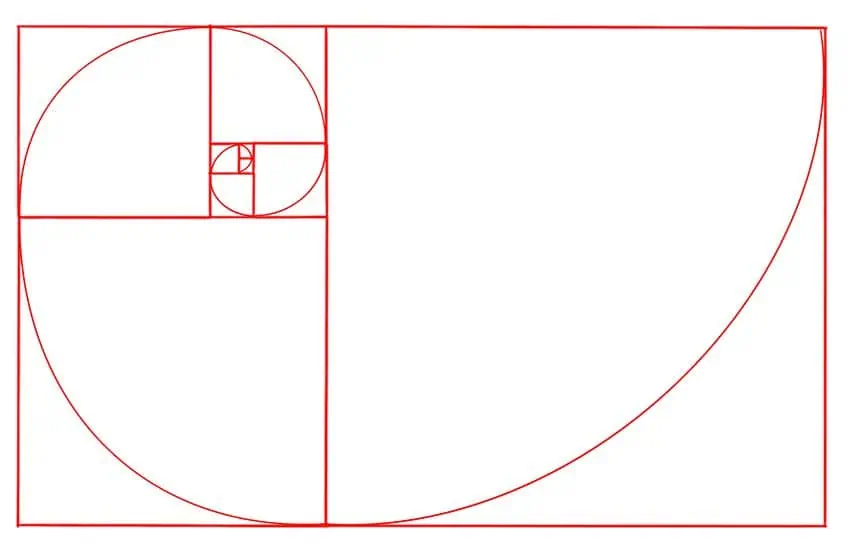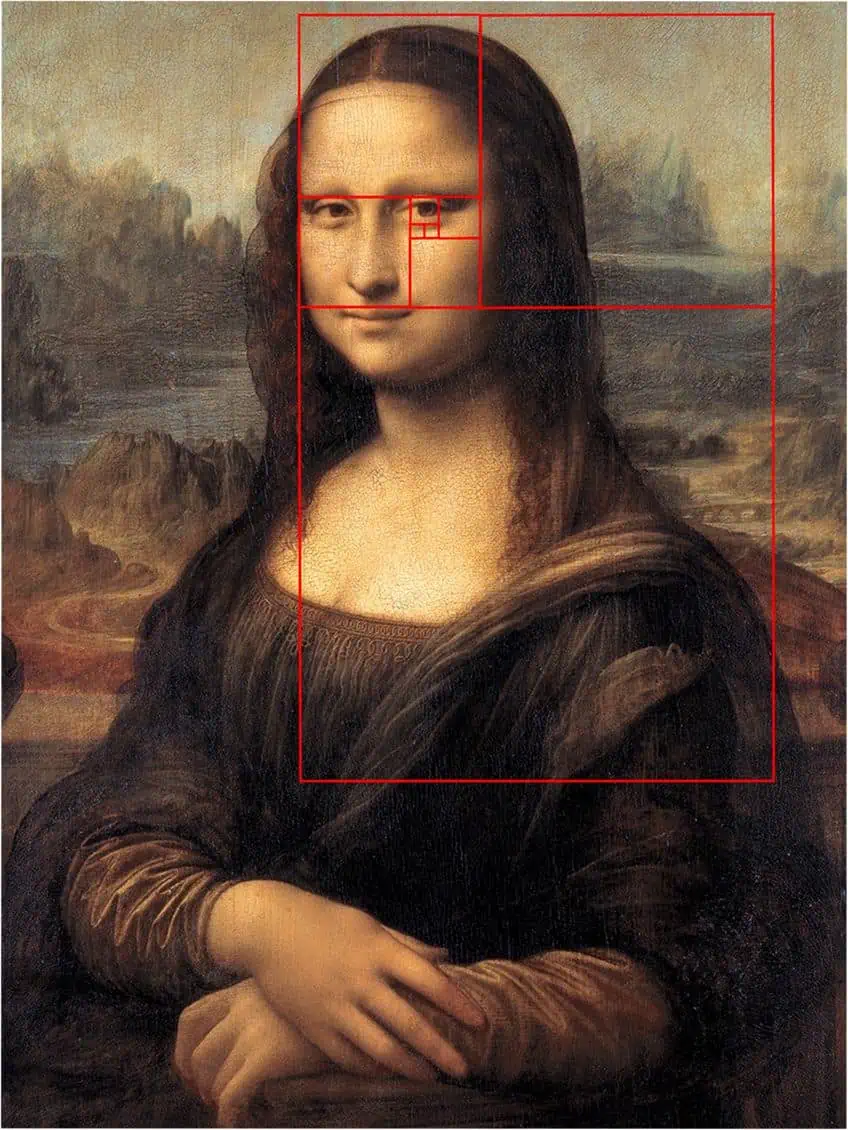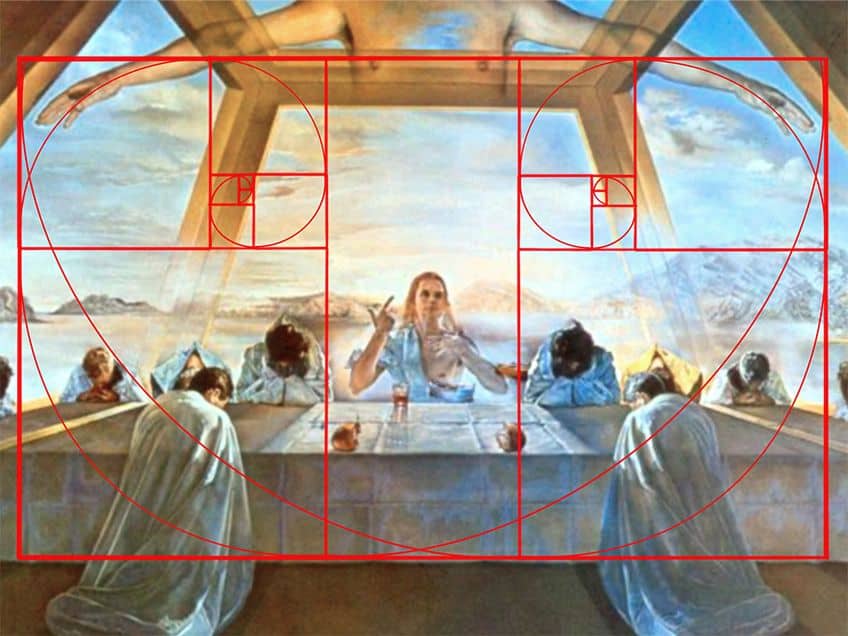Golden Ratio in Art – The Art of Perfect Proportions
The golden ratio in art is a concept that most of us find challenging to understand, due to its mathematical formulas and ideas of applying accuracy. This concept has been applied over the years in many areas, such as architecture, art, and other design elements. Let us see if we can help you understand and determine the use of the golden ratio in paintings.
What Is the Golden Ratio in Art?
A golden ratio composition, ultimately, comes down to a mathematical ratio. This has been determined as 1 to 1.618, where the decimal carries on into infinity and does not repeat. These numbers help you to determine the design and positioning of your subject so that it produces the most aesthetically pleasing image. As with most things in life, things are interconnected, and this is the same for art and mathematics.
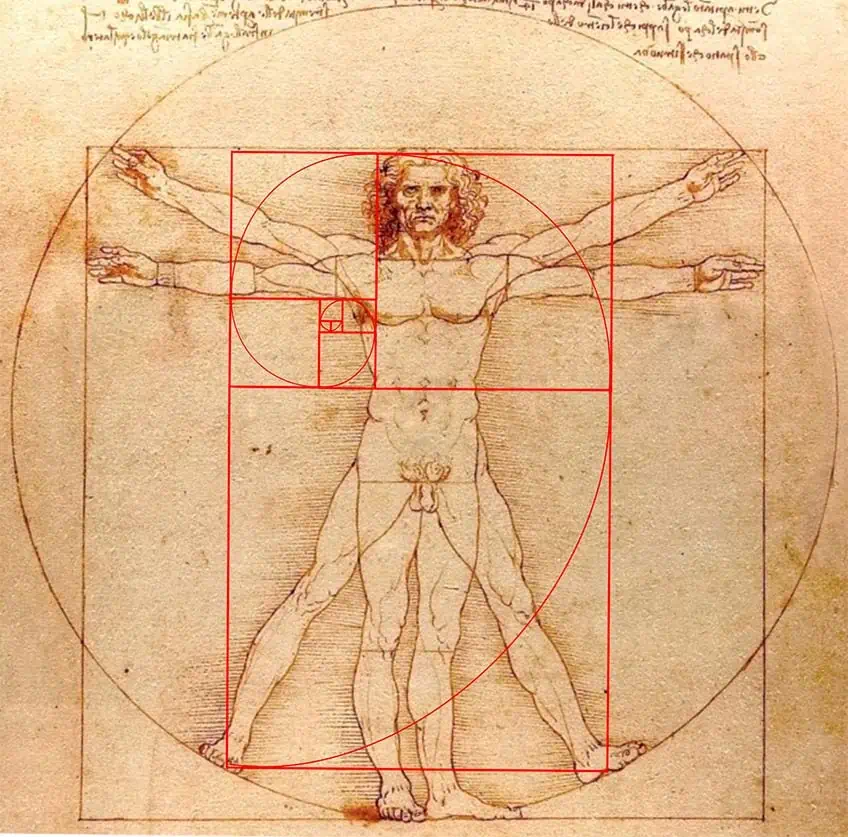
The golden ratio in art is mathematically calculated into the number ratio above and is also known by many other names, for example, the golden section or golden mean. It is also recognized as the divine section and can be connected to the Fibonacci sequence. The Greek letter phi, pronounced “fie”, is also part of the golden ratio, which is displayed as the ratio 1: Φ. When using the golden ratio in paintings, it helps to create perfect harmony and is the most aesthetically pleasing arrangement of elements.
Golden Ratio in Art: A Brief History
Many have been using the golden ratio composition for many years and has influenced many areas including architecture, art, and all forms of design. Many have used the idea both on purpose and maybe even unintentionally. While the idea has always existed in mathematics and the universe, it is not too clear when it was first discovered and used by man. It might even have been discovered and then rediscovered, which is why there are multiple names for the same concept.
Below are a few key moments throughout history, based on the information from photographer and author Priya Hemenway, who wrote the book Divine Proportion, Phi In Art, Nature, and Science (2005).
- Phidias (490 – 430 BC): A Greek sculptor, created the Parthenon statues that appear to contain the elements of the golden ratio.
- Plato (428 – 347 BC): An Ancient Greek philosopher, shared his opinions on science and the golden ratio in one of his dialogues, known as “Timaeus”.
- Euclid (325 – 265 BC): An ancient Greek mathematician is the first person to define the golden ratio, or “extreme ratio”.
- Fibonacci (1170 – 1250): An Italian mathematician who came up with the “Fibonacci Sequence”. This is a sequence, where each number is the sum of the two previous numbers. This is connected to the golden ratio.
- Luca Pacioli (1445 – 1517): Also an Italian mathematician, who described the golden ratio as the “divine proportion”, which is mentioned in his book of mathematics, the Divina proportione.
- Leonardo da Vinci (1452 – 1519): He was a great supporter of the “Divine Proportion” and used it in many of his works. Some of the drawings in Luca Pacioli’s book were done by da Vinci.
- Johannes Kepler (1571 – 1630): A German astronomer, discerned an elliptical pattern that the planets have around the sun. He also references the “Divine Proportion”.
- Martin Ohm (1792 – 1872): Another German mathematician, who was the initial person to use the term “Golden Ratio”.
- Mark Barr (1871 – 1950): A physicist, engineer, and inventor, who was the first to use the term “phi” for the golden ratio.
- Pieter Cornelis Mondriaan (1872 – 1944): A famous Dutch painter, who helped cultivate abstract art, applied the golden ratio to some of his works.
- Katsushika Hokusai (1760 – 1849): An artist from Japan, who also used the ratio in his works. One of his paintings, known as The Great Wave (1831), is said to display the golden spiral.
The Mathematics of the Golden Ratio
The golden ratio can be represented as a rectangle and square, which forms a larger rectangle. So, if you take the top line, it will have a longer and shorter section. This entire length can be represented as “a+b”. If you take this entire length and divide it by the longer section, which is “a”, this will be equal to the long section “a” divided by the shorter section “b”. So, the golden ratio of “phi” will look as follows if represented as an equation.
= = 1.618 or Φ
This sequence can then be repeated infinitely in this section. So, if you want to draw a golden rectangle, begin by drawing a simple square. This might not be completely accurate but should be close enough. Place a line down the middle and then from the bottom middle line that stretches to the top right corner of the square. You must use a compass for the next step.
Place one end of the compass at the bottom where the square is divided and take the other end of the compass and place it where you drew the previous line. Drag the compass down from this point to the bottom. From the bottom of the square, complete the rectangle by drawing a line out to the curved line you just made and completing the other rectangle edges. This new section created can then be repeated over and over again.
Squares and rectangles are simpler representations of the golden ratio, however, if by applying accurate math, it can be applied to many other geometric shapes from triangles and circles to prisms and pyramid shapes. You can also get the “Golden Spiral”, which is a spiral shape or line that continuously extends through the golden rectangle.
Where to Find the Golden Ratio?
There are many examples in nature where you can discern the golden ratio. Sometimes, we might find ourselves staring at something, wondering just how perfect it is. The ratio can be seen in seashell patterns or snail shells, and flower seed formations, such as a sunflower. Consider the image of a galaxy. You might even see it in spider web formations or pine cones. You can also consider hurricanes, plant petals, or DNA molecules. The cochlea in the ear and faces are also considered more attractive if symmetrical.
Some say that the golden ratio is evident in the Egyptian pyramids.
The Parthenon, which can be found in Greece is also said to display the features of the golden ratio. However, many would say that the golden ratio was not used on purpose, and was simply the attention to detail and geometric patterns and styles of the time. The golden ratio also only became known in about the 20th century. Today, it is recognized and used by architects in designs. Also, it is not only used by artists and architects, you will also find it in designs for websites and logos.
The Golden Ratio in Art
Architects follow a more accurate path when using the golden ratio. Artists and other designers might not have to be so accurate. When learning how to use the golden ratio in art, it can be used in the placement of important areas of your painting and can be measured in points within the rectangle. This will create an aesthetically pleasing image that appears to be well-balanced.
However, there is an easier method than using the golden ratio. The “Rule of Thirds” is more often used in art and photography. This rule is a guideline for artists as well as photographers and uses horizontal and vertical lines as a grid. At the meeting points of these lines, you will place a focal point.
The grid usually consists of three evenly spaced columns and rows, which provide nine equally sized squares to place over an image. This rule provides harmony and is easy to accomplish, with no worries about mathematical formulas and complex ideas. It also provides quite a few areas where you can make placements.
However, the placements can sometimes feel too forced. When using the golden ratio, this also means placing the subject along certain intersecting lines.
So, it is a similar idea, it is just more accurate and a little more challenging to achieve. Below is a collection of artists who have used the golden ratio within their works.
Leonardo da Vinci (1452 – 1519)
| Title | The Last Supper |
| Date completed | 1495 – 1498 |
| Medium | Tempera, gesso, mastic, and pitch |
| Dimensions (cm) | 460 x 880 |
| Gallery | Santa Maria delle Grazie, Milan, Italy |
| Place of origin | Milan, Italy |
We will start with Leonardo da Vinci, who applied this technique to many of his paintings and drawings. As mentioned, he even did illustrations for Luca Pacioli in his book. It is said to display some clear golden ratios.
Consider how Jesus is centered in the painting and the positioning of the disciples, which creates a visually pleasing and proportionate effect.

Michelangelo (1475 – 1564)
| Title | Creation of Adam |
| Date completed | 1508 – 1512 |
| Medium | Paint and plaster |
| Dimensions (cm) | 280 x 570 |
| Gallery | Vatican Museums, Vatican City, Rome |
| Place of origin | Sistine Chapel, Rome, Italy |
There has been some research done on this matter, and the new research suggests that there is evidence Michelangelo used the golden ratio, specifically a ratio of 1:6 when working on this painting in the Sistine chapel.
The finger of God, where it is touching Adam’s finger is said to be exactly where the divide is located in the golden ratio.
Salvador Dalí (1904 – 1989)
| Title | The Sacrament of the Last Supper |
| Date completed | 1955 |
| Medium | Oil paint |
| Dimensions (cm) | 267 x 167 |
| Gallery | National Gallery of Art, Washington D.C., United States |
| Place of origin | Catalonia, Spain |
A more modern example is that of a piece by the famous Salvador Dalí. In this painting, the ratio and dimensions used, are said to be that of the golden ratio.
The table as well as that of the two disciples next to Jesus are perfectly positioned within a section of the golden rectangle.
The Golden Ratio in Contemporary Art
The use of golden ratio has been used by artists in the past to create the perfect and most pleasing image or painting. Today, it can also be used to create amazing art pieces, and you can apply it to any canvas size. However, besides art, you can also use the golden ratio in anything, including things like aligning headlines, and body and text on websites.
You can also use it to help you size and crop photos, and of course, in buildings.
The use of the golden ratio has made it quite attractive to more modern artists, in the artistic fields of painting, photography, design, and even music. Whether these artists deliberately apply the technique and mathematical formulas is sometimes up for debate. Below are some more contemporary art examples.
Piet Mondrian (1872 – 1944)
| Title | Compositions in Red, Blue, and Yellow |
| Date completed | 1930 |
| Medium | Oil on canvas |
| Dimensions (cm) | 45 x 45 |
| Gallery | The Kunsthaus, Zürich, Switzerland |
Piet Mondrian, a Dutch artist, produced some landscape paintings, but he later also produced some abstract pieces. He used geometrical shapes as well as horizontal and vertical lines to express his ideas. He also shared in the beliefs of Leonardo da Vinci, that art and mathematics are closely related. This specific piece above is a contemporary work, which uses an arrangement of shapes and colors, which may include the use of the golden ratio.

Hans Hofmann (1880 – 1966)
| Title | Miller Hill |
| Date completed | 1941 |
| Medium | Oil on panel |
| Dimensions (cm) | 44.8 x 61 |
| Gallery | Artists Rights Society (ARS), New York, United States |
Hans Hofmann, who is the founder of modernism, used the golden ratio in many of his paintings. In the painting mentioned above, you will see a close formation of shapes located in the upper left-hand corner, a good spot when looking at the golden ratio. There is also a spiral in the image if you take a closer look.
Some say that it could be coincidental, but since he applied similar techniques in his other paintings, it is highly possible he was aware of the golden ratio principle and applied it knowingly.
Criticisms of the Golden Ratio in Art
The golden ratio is something that can be useful when used in paintings or photography to create well-balanced and engaging works. However, some artists simply think that you see what you want to see and that it has nothing to do with mathematics. That there is no evidence to say that the golden ratio makes for a more appealing effect when compared to less precise methods and that it does not show up any more than other methods.
The feeling is that you cannot simply pick a few examples you think contain the golden ratio, without comparing them to at least quite a few others. others.
Others think they should rather trust their own judgment instead of an outdated method used many years ago. When applying the golden rule, you might have balance and continuity, but that does not guarantee that the final piece is going to be appealing. Creating an appealing and beautiful piece of art requires more than a mathematical formula. You need to consider the subject, qualities of expression, colors, shapes, and forms, among other ideas. It is not simply the correct placement within a drawing or painting.
Some say there are no golden rectangles in ancient architecture, and that many other things like the mollusk shell patterns are more of a logarithmic spiral and not a golden spiral. It is also said that Leonardo da Vinci used other types of ratios that are written in his notebooks and did not apply the golden ratio. Also, in many other cases, the golden ratio is not present, and other ratios are found to be more popular. Today, many also blame the ideas on information that is copied and pasted so often, it becomes the number one idea.
Whether you believe what is written to be true or not, the golden rule has played a role in art and design for many years. It might not be to the extent that you think, but an idea can be as simple or as complicated as you want to make it, much like the golden rule. You can even try it out to discover for yourself!
Frequently Asked Questions
What Is the Golden Ratio in Art?
The Golden Ratio is a mathematical ratio that is represented by the number 1.618. The golden ratio also has many other names, such as the golden number and golden section, among others, and is also known as the Greek letter phi. It is used in art to create the best placement of subject and form.
Should Artists Use the Golden Ratio?
The golden ratio is considered to be more of a guideline in art, as only a few use it accurately due to there being easier methods. When discovering how to use the golden ratio in art, it is said that it creates the best, most harmonious, and most appealing effect when applied.
Does the Mona Lisa Display the Golden Ratio?
Yes, many agree that the Mona Lisa, painted by Leonardo da Vinci, possesses the golden ratio, which may be why viewers find this painting so appealing and fascinating.
Liam Davis is an experienced art historian with demonstrated experience in the industry. After graduating from the Academy of Art History with a bachelor’s degree, Liam worked for many years as a copywriter for various art magazines and online art galleries. He also worked as an art curator for an art gallery in Illinois before working now as editor-in-chief for artfilemagazine.com. Liam’s passion is, aside from sculptures from the Roman and Greek periods, cave paintings, and neolithic art.
Learn more about Liam Davis and about us.
Cite this Article
Liam, Davis, “Golden Ratio in Art – The Art of Perfect Proportions.” artfilemagazine – Your Online Art Source. August 21, 2023. URL: https://artfilemagazine.com/golden-ratio-in-art/
Davis, L. (2023, 21 August). Golden Ratio in Art – The Art of Perfect Proportions. artfilemagazine – Your Online Art Source. https://artfilemagazine.com/golden-ratio-in-art/
Davis, Liam. “Golden Ratio in Art – The Art of Perfect Proportions.” artfilemagazine – Your Online Art Source, August 21, 2023. https://artfilemagazine.com/golden-ratio-in-art/.


